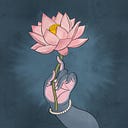Balarāma as ‘Dauji’
Balarāma is Kṛṣṇa’s elder brother and is himself a deity often associated with agricultural prosperity, responsible for the region’s fertility. Balarāma is affectionately referred to as Dauji, Daubaba, or Baladev. ‘Dau’ means elder brother in Brajabhāṣa, the local dialect of Hindi, and “ji” and “baba” are appended honorifics. Most images of Balarāma depict him as carrying a plow and a mace, tools that denote his agricultural and protective responsibilities.
However, popular iconography in the Braj region depicts Balarāma with right hand upraised, madira (wine) in the left, and frequently with a hooded Naga canopy. The popular images of both Balarāma and Kṛṣṇa are largely derived from the Bhāgavata Purāṇa, which situates Balarāma in his connection to the following: (1) the Pañcarātra Bhāgavata doctrine of Saṅkarsana as a vyūha (emanation); (2) the doctrine of Balarāma as the avatāra of Seṣanāga, the serpent upon which Viṣṇu rests; (3) Balarāma as heroic vīra of the Vṛṣṇis; and (4) Balarāma as brother and playmate of Kṛṣṇa.
Devotion to Dauji emerged in several centers in Braj, but Baldeo or Daujī today is the center of Balarāma devotion in Braj. Daujī is a small village approximately fifteen kilometers from Gokula, Balarāma’s birthplace. Prior to the manifestation of Daujī’s svarūpa (1638), what is now the village Baldeo was simply the Vidrumaban forest, used primarily for grazing cattle. According to Baldeo tradition, Daujī appeared to the Ahivāsī Braj cowherd Kalyāṇadeva in a dream in his yugal (joined) form along with his Revatī. Balarāma told him that his and Revati’s images were hidden under the banyan tree where Kalyāṇadeva had been doing penance. While on a pilgrimage to Braj shortly after the Mahābhārata war, Kṛṣṇa’s grandson, Vajranābha, had installed these images, yet, in the intervening years, they were buried and forgotten. On Mārgaśīrṣa Pūrṇima, Kalyāṇadeva unearthed these images, installed them under the tree and built a small temple. Gokulanātha, Vallabha’s grandson, attempted to relocate the Daujī image to Gokula: After all, Gokula is both Balarāma’s birthplace and an important seat for the Vallabha sāmpradāya. However, the Daujī tradition states that not even “one hundred fifty men or twenty-four oxen” could dislodge it from the site under the tree — a clear statement of Daujī’s preferences. Since that night, the full moon of Aghan (December), Daujī has remained in Daujī served by the lineage of Kalyāṇadeva, the Ahivāsī Gaur Brahmans, also known as the Paṇḍās, or Pandeys, of Daujī. These traditions are documented in the Balabhadra Mahātmya, a section of the Sanskrit text Gargasaṁhita, the biography of Kṛṣṇa and Balarāma traditionally ascribed to Garga, the family priest for Kṛṣṇa and Balarāma. These sevakas note that Daujī instructed Kalyāṇadeva himself about his preferences for sevā, and the daily (nitya) and yearly (utsava) sevā patterns reflect his wishes.
Daujī is merciful, protective and one who fulfills desires; he embodies the maryāda persona depicted (at times) in both the Mahābharata and the Bhāgavata Purāṇa. As maryāda-puruṣa, Balarāma is known for his attention to propriety and social decorum — virtues typically associated with Rāma. At the same time, Daujī is fond of intoxicants and is (sexually) aggressive — qualities that are also deemed to be maryāda in Balarāma’s case because Balarāma uses them in the service of righteousness. Every day, at 3 PM Daujī (and the [male] Pandas who serve him) receive bhang prasāda, and, at no other time of the year than Holī does this intoxicant flow freer in Daujī’s temple in Baldeo. This ties into the legend that while intoxicated, Balarāma forcibly relocated the Yamuna with the edge of his plow.
Paramānand, a sixteenth-century Braj poet, composed lyrics that describe his own vision of Holī (sung in the Rāga Sarang)
“She cries for the mercy of Gopāl.
The one who carries a plow is intoxicated and speaks to none.
He has diverted the Yamunā’s flow.
Eyes rolling, he staggers,
swaying as if at the peak of a mountain.
As if confused, he donned blue clothes and swallowed from a gold cup.
He roams from forest to forest with a thousand maidens, singing.
The pure hand of Balabhadra killed the demon Dvivid, the kin of Kaṁsa.
Long live Rāma, cheer the gods!
They shower him with countless Kusum blossoms.
He is the brother of Paramānand’s lord,
the diadem of the serpents, the limitless support.”
References:
- Holī through Daujī’s Eyes Alternate Views of Krishna and Balarama in Dauji, A. Whitney Sanford in Alternative Krishnas: Regional and Vernacular Variations on a Hindu Deity. United States: State University of New York Press, 2012.
- Sacred Play: Ritual Levity and Humor in South Asian Religions. United States: State University of New York Press, 2010.
__________________________________________
If you find value in my work, I hope you consider becoming a patron or making a contribution via UPI to hindu.aesthetic@okicici. Hindu Aesthetic requires a lot of time and effort and your support would mean that I can continue bringing you the best possible content. ❤
